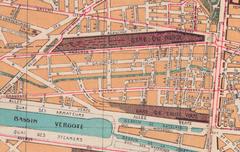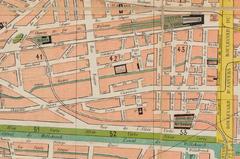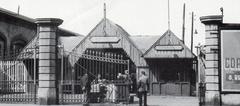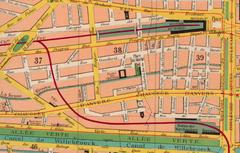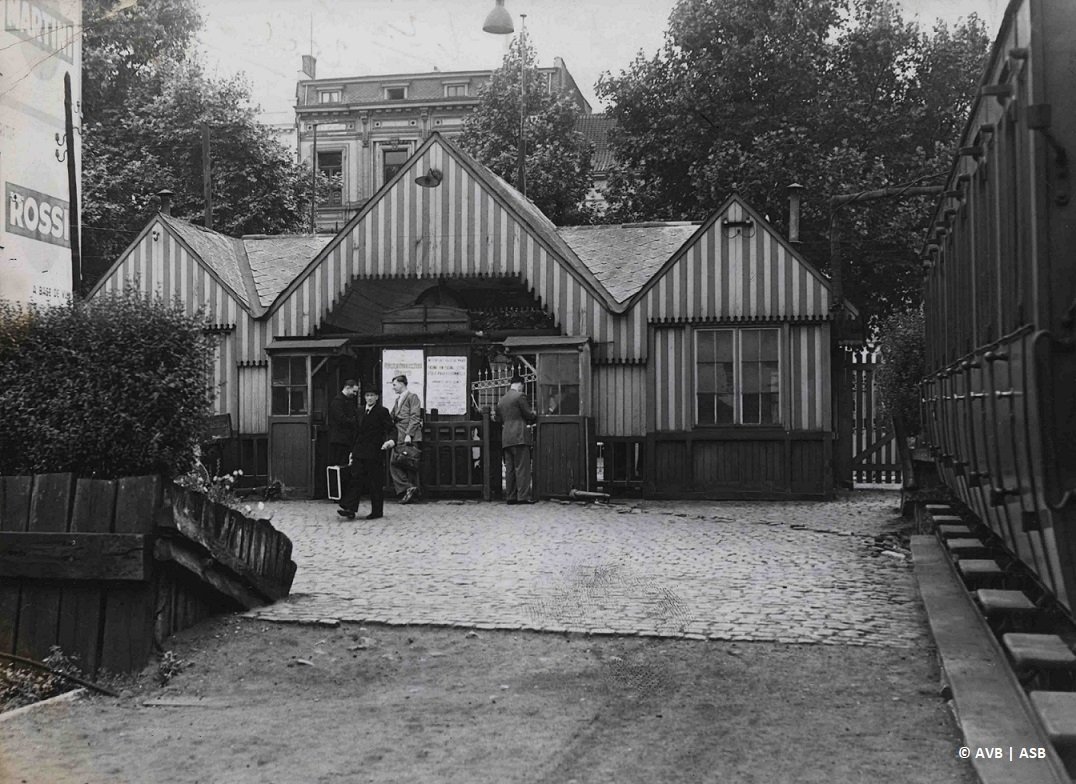
Brussels Allée-Verte Railway Station: Visiting Hours, Tickets, and Historical Significance
Date: 15/06/2025
Introduction
The Brussels Allée-Verte Railway Station (French: Gare de l’Allée-Verte; Dutch: Station Brussel-Groendreef) occupies a pivotal place in European transport history. Opened in 1835, it was the starting point of continental Europe’s first passenger train journey, signifying Belgium’s leading role in the industrial revolution. Although the original station was dismantled in the mid-20th century, its legacy lives on in Maximilien Park, a vibrant urban green space that blends historical remembrance with modern recreation. This guide provides an in-depth look at the station’s historical importance, practical tips for visiting its site, and nearby attractions for travelers and history enthusiasts.
Table of Contents
- Introduction: Discover the Legacy of Brussels Allée-Verte Railway Station
- Historical Overview
- Visiting the Former Station Site
- Exploring the Area: Urban Transformation and Attractions
- FAQs
- Resources and Further Reading
- Plan Your Visit
Historical Overview
Origins and Development
The Allée-Verte Railway Station was inaugurated in 1835, following the 1834 Belgian Railway Act that established a national rail network. Its strategic location near Brussels’ northern industrial quarter and port facilitated both passenger and freight transport. On May 5, 1835, the station hosted the inaugural train journey from Brussels to Mechelen, carrying 900 passengers over 22 kilometers in just 50 minutes—an event that positioned Belgium at the forefront of continental railway progress (ArchivIris).
The First Passenger Train
The ceremonial opening was a major public event, symbolizing industrial advancement. Passenger numbers rose rapidly, with up to five daily connections in each direction soon after opening. The Allée-Verte station’s early success helped transform Mechelen into a Brussels suburb and drew international attention to Belgium’s railways (Docutren).
Expansion and Decline
With Brussels’ continuous urban growth, the original Allée-Verte station could not keep pace with increasing traffic. By the 1840s, larger and more centrally located stations like Brussels-North replaced it for passenger services, while freight moved to Thurn and Taxis. Over time, the station became increasingly isolated and underused (ArchivIris).
Site Closure and Transformation
The Allée-Verte station closed in January 1954. Its buildings and tracks were removed to accommodate the Sabena heliport for Expo 58. In subsequent decades, the area hosted temporary events before being redeveloped into Maximilien Park, which now honors the site’s historical role while serving as a much-needed green space for the city (ArchivIris).
Lasting Significance
The Allée-Verte station remains a symbol of Belgium’s pioneering role in European railway history. By 1843, the country’s network already spanned over 550 kilometers. The memory of the station endures in city archives, museum exhibits (notably at Train World), and the transformed urban landscape (Train World).
Visiting the Former Station Site
Maximilien Park Overview
Today, Maximilien Park (Parc Maximilien/Maximiliaanpark) occupies the former station grounds. The park features walking paths, a city farm, playgrounds, and picnic areas, offering visitors a peaceful retreat in the heart of Brussels with an undercurrent of historical significance.
- Opening Hours: 7:00 AM to 10:00 PM daily
- Admission: Free
- Accessibility: Paved paths and accessible restrooms cater to visitors with reduced mobility.
Access and Directions
- By Train: Disembark at Brussels-North (Gare du Nord/Noordstation), a major hub just a 10-minute walk from the park.
- By Metro: Lines 2 and 6 (Yser/IJzer station), then an 8-minute walk.
- By Tram/Bus: Brussels-North is served by numerous lines. Check the STIB/MIVB website for details.
- By Bicycle/On Foot: The Promenade Verte trail and local bike lanes provide easy access.
Entry and Tickets
No tickets are required for Maximilien Park, the city farm, or the Promenade Verte trail.
Tours and Educational Visits
- Guided Tours: Heritage-themed walking tours often include Maximilien Park and the Allée-Verte site. Consult local tour operators and the Brussels City Archives for current offerings.
- School & Group Visits: The city farm welcomes group visits by appointment.
Nearby Attractions
- Train World: Belgium’s national railway museum in Schaerbeek, with exhibits on the Allée-Verte station (Train World).
- Tour & Taxis: A revitalized industrial complex hosting events and markets (Visit Brussels).
- Brussels Canal: Scenic walking and cycling paths along the revitalized waterfront.
- Botanic Garden of Brussels: A nearby oasis for nature lovers.
Best Visiting Times & Photo Spots
- Best Times: Spring and summer for ideal weather; weekdays for a quieter experience.
- Photo Spots: Park greenery, city farm, canal views, and historical information panels.
Exploring the Area: Urban Transformation and Attractions
The Allée-Verte station site is part of Brussels’ Northern Quarter, a district that has evolved from an industrial hub to a modern business center (Monument Heritage Brussels). Avenue de l’Héliport and Place Gaucheret align with the former railway tracks and station approach, while the Allée Verte avenue maintains its historic name and layout. The juxtaposition of 19th-century industrial elements and modern high-rises makes the area especially appealing for urban explorers and photographers.
A short walk leads to the Tour & Taxis complex—an excellent example of adaptive reuse of industrial heritage—and to the Brussels–Vilvoorde canal, now a lively corridor for recreation. The Grand Place and Mont des Arts are also within easy reach.
Frequently Asked Questions (FAQ)
Is the Allée-Verte station still standing?
No, the original buildings were demolished in the 1950s. The site is now Maximilien Park.
Can I visit the exact site of the station?
While no physical structures remain, interpretive signage and the park’s layout help visitors connect with the site’s history.
Are guided tours available?
Yes, several local tour operators and heritage organizations offer guided walks that include the area.
Is the area accessible for people with mobility challenges?
Maximilien Park is largely accessible, with paved paths and accessible facilities.
Are there entrance fees?
No, both Maximilien Park and the Promenade Verte are free to enter.
Resources and Further Reading
- ArchivIris Brussels City Archives
- Train World Museum
- Docutren Railway History PDF
- Monument Heritage Brussels
- Visit Brussels
- Wikimedia Commons – Allée-Verte Station
- Wikipedia – Northern Quarter Brussels
- Promenade Verte Information
- STIB/MIVB Public Transport
- Handy.Brussels Accessibility Guide
Plan Your Visit
Explore the site where European railway history was made by strolling through Maximilien Park and along the Promenade Verte. Access is easy via Brussels-North station, and the area offers a range of attractions from green spaces to modern business architecture. For a deeper dive, visit Train World and join a guided heritage walk. Download the Audiala app for curated walking tours, audio guides, and up-to-date event listings.
Enjoy your journey into Brussels’ rich past and vibrant present—and don’t forget to share your discoveries with fellow travelers!

